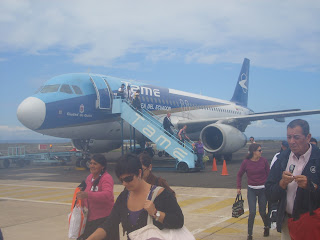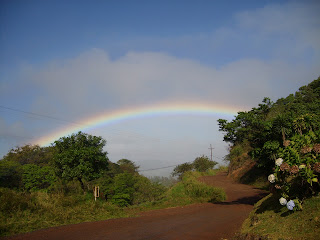Monday, February 28, 2011
A special thanks
To my family and friends for all their support. The love and support of many made this dream possible. A special thanks to my college roommate and best man, Skip Allen. Skip came to assist me through all the transportation issues that were so difficult for me. He also had a great time as did I.
A typical beach on the Galapagos Islands
The water temperature was about 78 degrees and the waves were gentle. They are pristine and undeveloped one way the people of the Galapagos are controlling the number of visitors to their paradise.
A tortoise breeding station
Tortoise eggs arre hatched here and protected from predation. Humans have introduced rats, cats and dogs which have become feral and prey on young tortoises. The tortoises are raised till about 10 years old then released to the environment. The largest island, Isabella, has 5 different species of tortoises it was formed by 5 different volcanos. There is some evidence to suggest that a unique species evolved on each volcano and then the continuing lava flows brought them all together.
At sea level the mangroves help creat soil and provide protection
There are four type mangroves in the Galapagos. They are established in areas of different salinity. One type only grows in fresh water and the US Army used this information to find fresh water while constructing an airbase in the Galapagos during World War II
View from the top of the volcano
The photo is from about 1800 feet above sea level. There are no roads to take one to the rim. Hiking up the path takes about an hour and a half. The rain clouds are closing in, and being the rainy season, well it rained. We got soaked on the way down but up early enough to get some good photos and views.
The second largest exposed caldera in the world
The view is across a lava field (cooled) below the rim of the volcan negra. The distance is reported to be 18 kilometers. The last eruption was in 2005. The lava chamber is only 2 kilometers below the surface in this area.
Soil building
The rocks are all from lava flows of ancient volcanos. The while is a lichen that is breaking down the rocks to form a soil. This is the foundation for the plant life on these islands. which range in age from 50 million to 1 million years.
A penguin and blue footed boobies taking a break
The penguin is on the left. There are only about 200 in this area so we were fortunate to see them. They are so fast in the water that I could not get a photo of them.
Different Isla same behavior
This was taken in the port of the island Isabella. There are many species that evolved with unigue charactistics on individual islands. The sea lions have concluded that boats are better than rocks or park benches for a rest between meals.
Marine iguanas nest building
The creatures here are not afraid of humans. This is a nesting site for these iguanas. They are ungainly in water but extremely efficient in the water. They have very long digits on their feet and can hold onto rocks while being pounded by the surf. they eat algae. The only predator is the frigate bird which will dig up and eat the eggs.
This formation is called Kicker Rock
The rocks are about 180 feet tall and the gap between them about 40 feet wide. The water is about 50 feet deep here. This is the best snorkling I have done to date. The many colored coral formations on the walls are spectacular. The marine life we observed included: sea turtles, manta rays, puffer fish and three kinds of sharks (white tip reef, black tip, and galapagos) The last was about 8 feet long. Fortunately for us they were resting and would leave at night to hunt.
A different day at the beach
Sea lions make themselves comfortable everywhere in the Galapagos. They are so graceful in the water, as I had a few opportunities to observe and swim with them. Some choose to lounge the day away on a bench and the more ambitious choose to sleep in the boats moored in the harbor. They hunt at night.
Tuesday, February 15, 2011
Ever hopeful
This pelican watched while we fished for awhile. As we started winding in the fishing line (empty) this bird swooped up to the rear of the boat looking for a handout. We thought he might try and take the lure but he was too smart for that. It is amazing how they can fly inches above the water and account for the swells and waves.
The commericial district on San Cristobal
This is the scene that greets a visitor. They have addressed the water with this park area, The sea lions flop where ever they want and everyone walks around them. Most of the commerical district is within 5 blocks of this point.
The harbor on San Cristobal
A collection of working vessels and pleasure craft. There are water taxis to ferry people and gear put to these boats. A very interesting operation as people are will to wait their turn.
Sea Lions relaxing on the beach
A protected beach on Santa Fe Isla. The sea lions took full advantage of this beautiful setting in these reef proected shallow waters.
Saturday, February 12, 2011
Snorkling near another Island we swam with these creatures
They are so quick and graceful in the water. That is cooled lava they are walking on. The guide was able to call them out into the water when we were there. The water temperature is 78 to 80 degrees, too hoy for sharks.
A blue footed booby
This bird was fishing near the port. I only saw a missed attempt but the bird sure looked healthy. We went snorkling near this area and saw lots of fish on the reef and were lucky enough to swim with a green sea turtle. That was really cool.
Friday, February 4, 2011
I have been truly blessed
At least 3 miles of the road ride this morning had this view. It takes about 20 minutes to go those three miles so this was significant. maybe it was the luck of the Irish. I am thankful for all the blessings bestowed upon me and for all the great friends and support groups that Robin and I have.
Hognosed bats
The black spotches on the bottom of this branch are bats. It is amazing how adaptive each species is. They are almost perfectly flat on the branch.
A view of the Rainforest in Costa Rico
Almost every photon that arrives in this area is caught but some plant. The plants even grow on the bark of trees. In the distance you can see the cloud. This is actually called the Monteverde Cloud Forest
Subscribe to:
Posts (Atom)





























